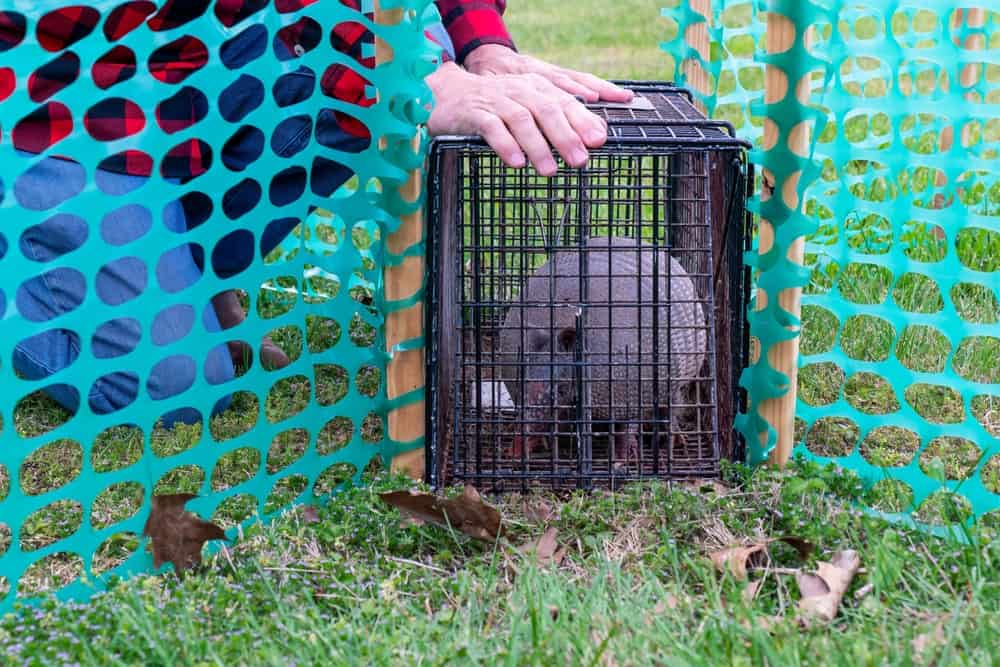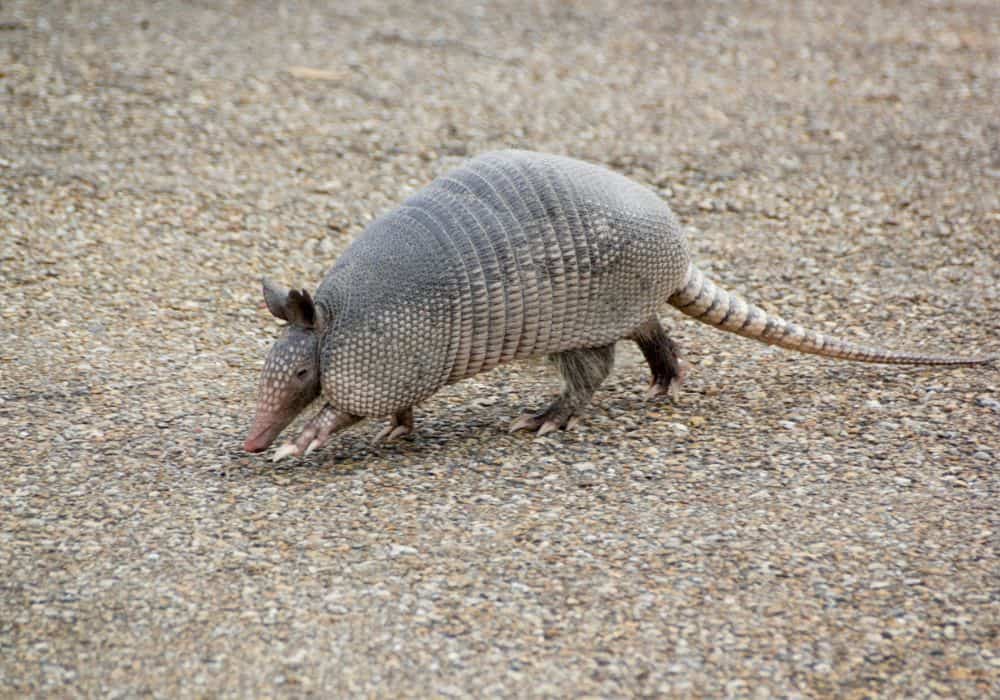Armadillos are not the cutest animals to keep around, especially not when they’re out in your yard, wreaking havoc. You’ll often find these critters active at night, leaving a wake of destruction across your well-maintained lawn while looking for food.
We can’t have them destroying your garden because they’re a bit hungry for grubs. We need to get them off our plot in the most humane way possible, which is by trapping them. You’ll find out in this article that it can be quite easier than you thought it could be.
What You’ll Need
A Cage Trap
You don’t have to prepare a lot to trap an armadillo. To successfully capture this nuisance animal, you really only need a large cage trap. You’ll need it to be 30 inches long, 12 inches high, and ten inches wide: big enough to keep a raccoon inside.
You’ll also need to make sure that the trap is sturdy enough. Armadillos can go around 17 pounds, so you need the trap to be durable enough to keep the animal in as you transport it to a far place away from your home.
There are two kinds of traps that you can find in the market. The one-door trap is the cheaper one, and it can get the job done pretty well. However, since it only allows the armadillo to go in through one side, you are limited with the areas you can place it to maximize the possibility of capturing the rogue armadillo.
The second kind is the two-door trap, which is the more expensive of the two. As its name suggests, it features two doors that armadillos can come in through. This means that you have more flexibility in the deployment of these traps.
Whichever trap you go for, make sure that it’s durable enough to handle large animals like the armadillo, since these creatures can be quite big. They usually come around the size of raccoons and opossums, so traps for these animals should work for armadillos, too.
Additionally, you will need protective gear, such as thick leather gloves, when handling caught armadillos. Getting some cayenne pepper and castor oil as armadillo repellent would also help in getting these creatures off your backyard.
What About Bait?
Here’s the thing about armadillos: they only eat food that they themselves dug up from the ground. Their diet primarily consists of earthworms and small insects such as cockroaches and termites. Unlike most animals, however, they won’t jump at the sweet offer of these foods right away.
In fact, putting bait on your armadillo trap might even affect the success of your endeavor, since other creatures that feed on these same bugs, such as raccoons, may instead be captured by the trap. (Although if you also have a raccoon problem, this might work out well).
Instead, you just need to let the trap do its magic.
Steps to Trap an Armadillo
Step 1: Identify their pathways
You want the armadillo to just prance its way to the trap as naturally as possible. To effectively do that, you need to know where it passes as it digs through your yard. If you have been tracking the armadillo over time, you should already have a pretty good idea of where its burrows are.
If not, then you don’t have to fret. Armadillos don’t really put in the effort of hiding their presence. You’ll easily find the wake of destruction that they leave as they dig through the ground. It’s also likely that you’ll find more than just one burrow in one lawn, so you shouldn’t have a hard time finding one.
As you go through these burrows, you’ll also notice that a few burrows are bigger than the others. Most burrows are often small escape routes that they dig through from the “main” one, which you can expect that they will frequently visit. Finding this main burrow will greatly improve your chances of catching the armadillo.
If you have no luck finding these burrows, then you can simply look at the recessed grass and trail of holes that should have been littered all over your lawn. These are good enough pathways that the armadillo passes through every night.
Step 2: Place the trap along their path
This should be the easiest step since you just need to set the trap along the pathways that you found. An important thing to remember when putting down your trap is to make sure that it is stable and doesn’t move around even when being pushed around. You don’t want it to make unnecessary movements and noise when the armadillo goes inside it.
PRO TIP: Again, don’t place bait on the trap. You will end up attracting other animals, which may decrease the efficiency of your trap. Although some will try to place baits on the way to the trap, experts have said that this does not make your trap any way better.
For one-door traps, you need to get creative with how you position them since you only have one side that the armadillo can go through. Most people “persuade” or encourage the armadillo by making barriers toward the trap using wooden planks or a custom fence with wooden poles and construction fencing. Complement this by digging a shallow pathway toward the trap.
Forming a funnel-shaped fencing that terminates into the trap works really well because armadillos have poor eyesight and rely on their sense of smell. They simply bump into the fence until they reach the trap. This is also why the trap needs to be stable.
If you have a two-door trap, it can be more effective since you can simply slot the trap into any pathway that the armadillos might pass through. They can come through either side, so you have more options for placing the trap.
Step 3: Check the trap every morning
Now comes the fun part. Catching an armadillo will take some patience, but at least you simply need to wait and check the trap every morning. Armadillos are nocturnal animals, so after setting the trap, you wait out for the night when they become active.
You might need to wait for a few mornings before you get the armadillo, so don’t get discouraged if the first night doesn’t yield a successful capture.
Step 4: Handle the trapped armadillo with care
If you wake up one morning with the clinking of a trapped armadillo inside the trap, then congratulations! However, you should be careful when dealing with armadillos. As experts in digging and clawing through soil and ground, they have sharp claws that can easily injure even an adult human.
Make sure that you wear thick leather gloves so that you avoid getting injured when the armadillo tries to reach out through the grills. This is also to avoid getting into contact with the trapped animal in general since they are also known to be carriers of leprosy.
Now, if your local wildlife regulations allow it, you can drive to an approved relocation area for wildlife that is at least five miles away from your house. Place a rag or a tarp underneath the trap to catch the dirt, then comfortably place the trap on the trunk of your car. Drive to the area and set them free there.
Of course, if you are unsure of how to handle the armadillo, you can always call your local professional wildlife control operators. They know how to remove the critter and make sure that it doesn’t make its way back into your garden.
Step 5: Prevent them from coming back
Now that the main threat is gone, that doesn’t mean that another won’t come back. You should prime your area such that they will not come digging through your lawn again.
Although reducing their food sources is often the first thing you’d want to do, it can be impossible for armadillos since their diet of worms and small insects is hard to completely exterminate. However, you can reduce low-lying covers, such as shrubs and brushes, since armadillos are not fond of being out in the open.
There are also a few deterrents that you can place in your garden. Armadillos have been known to abhor the scent of castor oil, so sprinkling some around your lawn should keep those pesky critters off your perimeter. Plus, castor oil spoils the taste of worms, so those armadillos will never come back after getting a taste.
Cayenne pepper is another good deterrent since armadillos also don’t like their smell.
Conclusion
Armadillos can wreak havoc on your garden, and they can be quite pesky to handle, given that they spend a lot of time underground. If you want to capture the one that’s been giving your lawn an unwanted digging makeover, you need to be patient and let the trap do its thing.
There’s rarely a reason to resort to violent methods of extermination since armadillos are generally people-shy. Their sharp claws are for digging and grabbing food from the ground, not for hurting people. If you are not confident about handling them, it’s better to call the professionals on armadillo removal and let them handle the problem.


